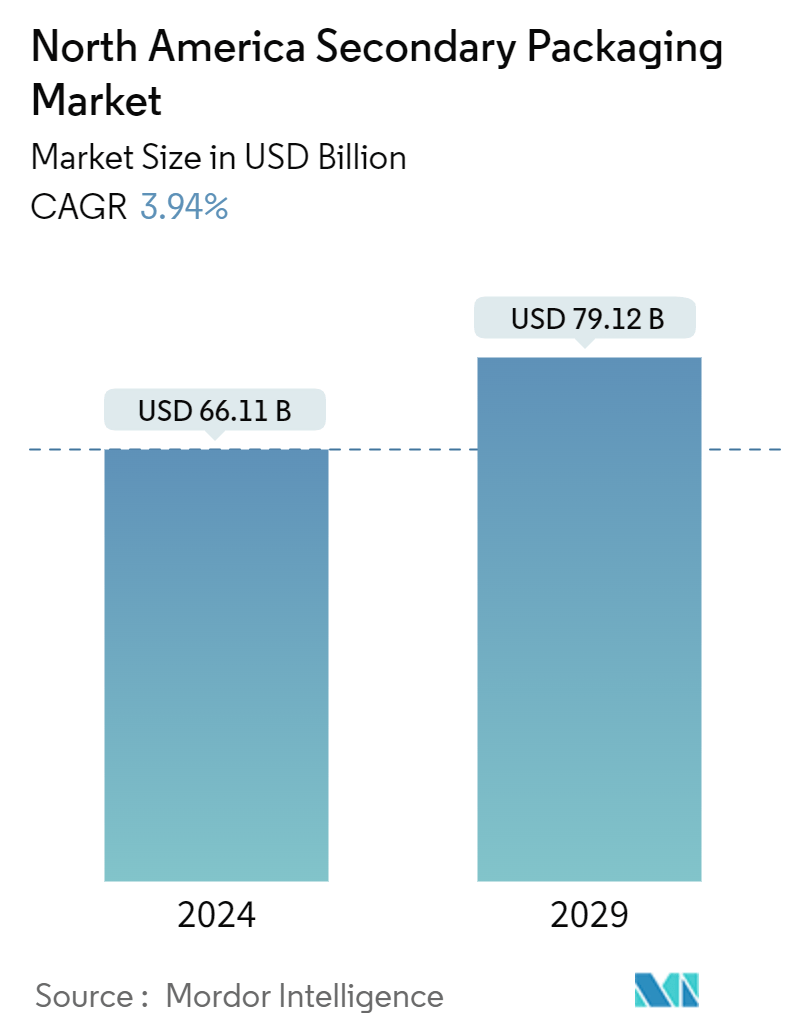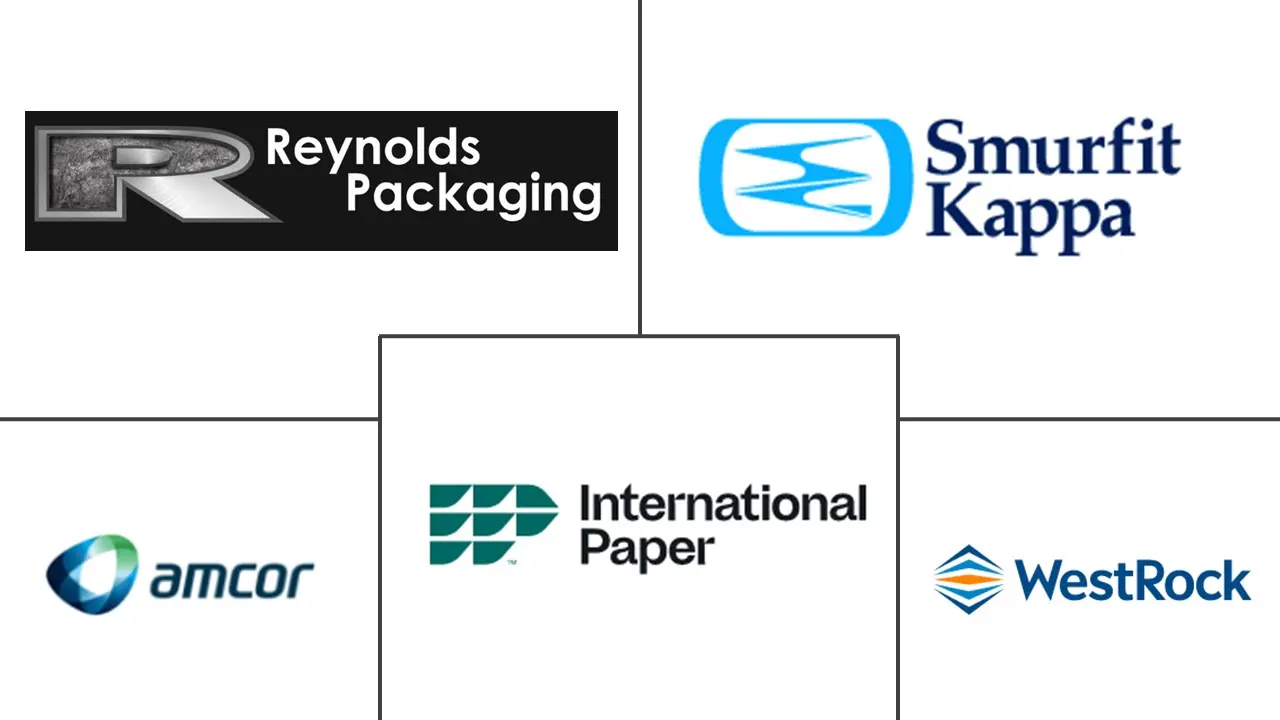Market Size of North America Secondary Packaging Industry

| Study Period | 2019 - 2029 |
| Base Year For Estimation | 2023 |
| Market Size (2024) | USD 66.11 Billion |
| Market Size (2029) | USD 79.12 Billion |
| CAGR (2024 - 2029) | 3.94 % |
| Market Concentration | Low |
Major Players
*Disclaimer: Major Players sorted in no particular order |
North America Secondary Packaging Market Analysis
The North America Secondary Packaging Market size is estimated at USD 66.11 billion in 2024, and is expected to reach USD 79.12 billion by 2029, growing at a CAGR of 3.94% during the forecast period (2024-2029).
The North American secondary market was estimated at USD 60.40 billion in the previous year. The market is expected to reach USD 76.76 billion over the forecast period, witnessing a CAGR of 3.94%. The United States and Canada are massive consumer markets, and the population's considerable buying power makes it a lucrative market for all package suppliers. As a result, the North American secondary packaging market is anticipated to grow over the upcoming year due to the growing demand for food packaging, a string of successful e-commerce transactions, and the demand for safety in packaging transportation.
- The rising use of environment-friendly materials in packaging is driving the secondary packaging market in North America. Packaging that is recyclable, biodegradable, reusable, non-toxic, and has a minimal environmental impact is considered eco-friendly. The need for environment-friendly packaging materials is becoming increasingly apparent to end users, including the food and beverage industry and manufacturers of household care products. Packaging formats like folding cartons and corrugated boxes have no adverse effects on the environment because they are constructed of recyclable and biodegradable materials, such as paperboard.
- The demand for convenience foods is on the rise due to the busy lifestyle of people. As corrugated board packaging keeps moisture from the products and withstands long shipping times, companies are increasingly adopting it to offer customers better outcomes, especially secondary or tertiary packaging. Processed foods, such as bread, meat products, and other perishable items, need these packaging materials to be used once, thereby driving the demand.
- Since the corrugated board is easy to recycle and the pulp and paper industry is already skilled at converting it into new generations of containerboard, it is becoming increasingly common in packaging as sustainability concerns become more relevant across the value chain. Due to these benefits, corrugated protective forms have gained popularity over polymer-based substitutes, such as expanded polystyrene (EPS) foams.
- Additionally, increasing courier and messengers' revenue indicates the use of secondary packagings, such as corrugated boards and folding cartons packaging, in transiting the products from one place to another. According to the US Department of Commerce, in 2021, the US couriers and messengers generated almost USD 137.91 billion in operating revenue. UPS is the largest courier and delivery service provider in the United States, with around 40% of the courier market.
- Secondary packaging still raises environmental questions, but there are also other challenges to solve. In online purchasing, all have encountered the bother and disappointment of receiving a flawed, incomplete, or inaccurate product due to subpar or insufficient secondary packaging. However, since secondary packaging comes after primary packaging, any issues resulting from a stoppage impact the rest of the production line. Production and delivery plans are disrupted by downtime, which also increases product waste and brings labor expenses back into the expense column. Production planning should ideally include anticipating and reducing stoppages through advanced planning.
North America Secondary Packaging Industry Segmentation
Secondary packaging includes outer material that protects food, drinks, and consumer goods throughout transit. Secondary packaging is the exterior packaging of the primary packaging that groups a package and further protects a product.
The North American secondary packaging market is segmented by product type (corrugated boxes, folding cartons, plastic crates, wraps and films, and other product types), by end-user industry (food, beverage, healthcare, consumer electronics, personal care, household care and end-user industries), by country (United States and Canada). The report offers market forecasts and size in value (USD) for all the above segments.
| By Product Type | |
| Corrugated Boxes | |
| Folding Cartons | |
| Plastic Crates | |
| Wraps and Films | |
| Other Product Types |
| By End-user Industry | |
| Food | |
| Beverage | |
| Healthcare | |
| Consumer Electronics | |
| Personal Care and Household Care | |
| Other End-user Industries |
| By Country | |
| United States | |
| Canada |
North America Secondary Packaging Market Size Summary
The North American secondary packaging market is poised for significant growth, driven by the robust consumer markets in the United States and Canada. The region's substantial purchasing power makes it an attractive landscape for packaging suppliers, with increasing demand stemming from sectors such as food packaging, e-commerce, and transportation safety. The market is characterized by a shift towards eco-friendly materials, with recyclable and biodegradable options like corrugated boxes and folding cartons gaining traction. This trend is fueled by the rising awareness among consumers and industries, including food and beverage and household care, about the environmental impact of packaging. The demand for convenience foods and the need for durable packaging solutions to withstand long shipping times further bolster the market's expansion.
In Canada, the burgeoning e-commerce sector is a key driver of demand for secondary packaging, particularly corrugated and paper-based materials. The country's advanced e-commerce infrastructure, closely linked with the United States, has led to a significant increase in online consumer sales, prompting a rise in the use of packaging solutions that are both cost-effective and environmentally friendly. Major players in the market, such as Amcor PLC, International Paper Company, and Westrock Company, are actively engaging in strategic initiatives like acquisitions and partnerships to enhance their market presence and focus on sustainable packaging innovations. These efforts are complemented by regulatory pressures and consumer preferences for green packaging, further shaping the dynamics of the North American secondary packaging market.
North America Secondary Packaging Market Size - Table of Contents
-
1. MARKET INSIGHTS
-
1.1 Market Overview
-
1.2 Industry Value Chain Analysis
-
1.3 Industry Attractiveness - Porter's Five Forces Analysis
-
1.3.1 Bargaining Power of Suppliers
-
1.3.2 Bargaining Power of Buyers
-
1.3.3 Threat of New Entrants
-
1.3.4 Threat of Substitutes
-
1.3.5 Intensity of Competitive Rivalry
-
-
1.4 Assessment of the Impact of COVID-19 on the Industry
-
-
2. MARKET SEGMENTATION
-
2.1 By Product Type
-
2.1.1 Corrugated Boxes
-
2.1.2 Folding Cartons
-
2.1.3 Plastic Crates
-
2.1.4 Wraps and Films
-
2.1.5 Other Product Types
-
-
2.2 By End-user Industry
-
2.2.1 Food
-
2.2.2 Beverage
-
2.2.3 Healthcare
-
2.2.4 Consumer Electronics
-
2.2.5 Personal Care and Household Care
-
2.2.6 Other End-user Industries
-
-
2.3 By Country
-
2.3.1 United States
-
2.3.2 Canada
-
-
North America Secondary Packaging Market Size FAQs
How big is the North America Secondary Packaging Market?
The North America Secondary Packaging Market size is expected to reach USD 66.11 billion in 2024 and grow at a CAGR of 3.94% to reach USD 79.12 billion by 2029.
What is the current North America Secondary Packaging Market size?
In 2024, the North America Secondary Packaging Market size is expected to reach USD 66.11 billion.

